| In 1873 Samuel Griffiths' wonderful book "Griffiths'
Guide to the Iron Trade of Great Britain" appeared. The
book is by far the best work produced about British iron
and steel manufacturing in the late 19th century. Samuel
Griffiths was a businessman, a merchant and
factor, who drifted into the iron trade, and came to intimately know the industry, and many of the manufacturers. Griffiths was born
in Bilston in 1814. He lived in Wolverhampton from 1849
until 1866, and would have been very familiar with
Willenhall and its manufacturers. Whilst in
Wolverhampton he began to publish a circular for the
iron trade called "Iron Trade Circular".
I have included two
descriptions and several adverts from the book. Although
the book was published in 1873, the research, which
involved extensive travel throughout the country, would
have taken several years to complete, and so the
descriptions were written sometime in the early 1870s.
After moving to London he continued to publish his
"Iron Trade Circular", until 1873 when it became the "London Iron Trade Exchange". He
continued to publish it until his death on the 24th May,
1881.
Willenhall and its
Locks and Bolts |
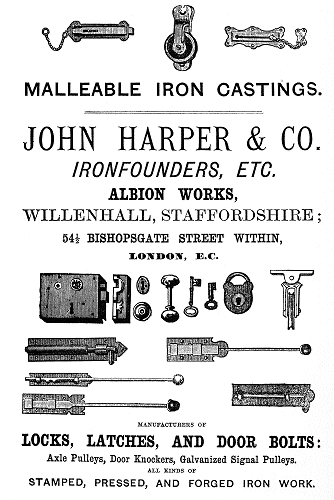 |
Willenhall, the real seat of the lock, door-bolt,
and latch manufacturers for the world, is a township in
the parish of Wolverhampton, and is connected with it by
two lines of railways, viz. the old Grand Junction line,
and one recently opened, the Wolverhampton and Walsall
line.
Willenhall being just three miles from either town,
now contains about 20,000 inhabitants, a complete hive
of industry. We believe there are some five to six
hundred separate manufactories (of course some only
small concerns) of rim, mortice, drawback, dead,
cupboard, drawer, box, and pad locks; all kinds of
latches and door bolts; currycombs, gridirons, box-iron
stands, and skewers; horse scrapers and singers;
carpet-bag frames and locks; box corners and clips; keys
of all descriptions; and stampers of an endless variety
of articles for the gun, steel, toy, and other trades
carried on in neighbouring towns.
There are also ironfounders, brassfounders, and
wrought Ironworks, blast furnaces and collieries in
abundance. To these mainly must be attributed the rapid
growth of this industrious town. |
| The writer can well remember when three to four
thousand was the extent of its population. In those
happy old days of the past there was one church, with a
blaspheming drunken parson, who spent six times more of
his time in the public house than in the church, the
only one the place possessed.
In those times there was no Methodist or Dissenting
resident minister; and what is more, no magistrate, no
lawyer, no police, and not an inhabitant (except the
parson) but what was engaged in some kind of business.
At the present time the township of Willenhall
contains four churches, five Wesleyan chapels, four
Baptist chapels, five Methodist chapels of various
denominations, and one Roman Catholic chapel, which
represents one place of worship for every thousand of
the population, a fact few towns can boast of; with good
school accommodation, British, National, and Wesleyan,
and a literary institute of no mean pretensions, having
its reading, recreation, and class rooms, a good lecture
hall, and a well-furnished library. |
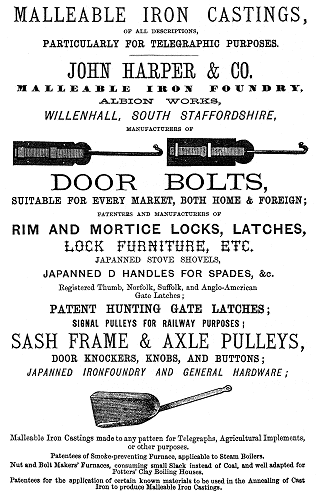 |
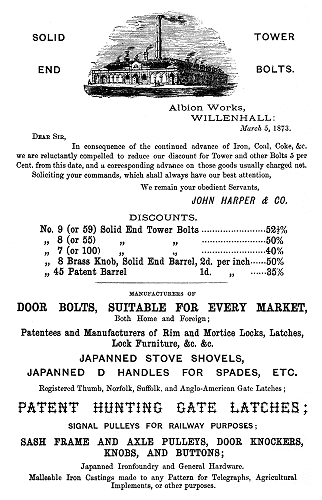 |
On visiting some of the manufactories of Willenhall,
we found the Albion works one of the most prominent,
employing some hundreds of work-people.
The business carried on here was established in the
last century by the father of one of the present
proprietors; and one of the principal branches of the
trade, that of door bolts, was extensively carried on by
the grandfather of the other more than eighty years ago.
At these works we find manufactured rim, dead, and
mortice locks; spring, rim, night, Norfolk, Suffolk, and
Lancashire thumb-latches, in various ornamental designs;
door-bolts in prodigious quantities.
When in full employ they can produce 120 gross per
week of this one article, aided by steam stamps,
Nasmith's steam hammer, and steam presses for forming
the various parts of the bolt, and piercing the holes in
the plates; also pulleys for every conceivable purpose;
sash, signal, and sliding doors; hat and coat hooks;
door buttons, and black ironfoundery generally.
We also find a large quantity of door-lock knobs,
sold principally for export, called 'Harper & Co.'s
patent mineral lock furniture.' |
|
At the time we write, they are
engaged on orders for nearly 100,000 brackets, made of
malleable cast Iron-these are for various telegraph
lines, both for home and abroad. In this branch the
Messrs. Harper & Co. excel.
Our pen would fail to write the
variety of purposes to which the malleable castings are
now applied; suffice it to say, their patterns consist
of more than three thousand different kinds and sizes.
The largest lock manufactory here,
and perhaps one of the oldest, is Carpenter &
Tildesley's, well-known in England and all the Colonies
for their locks of various kinds, particularly 'rim'
locks.
They are the largest lock and
curry-comb makers in Willenhall, and employ the greatest
number of hands in lock and key making of any house in
Willenhall, having especial machinery for this purpose.
This firm stamp their own keys. Mr.
James Tildesley is son-in-law to the late Mr. Carpenter,
and is the proprietor of these ingenious works. This is
a highly respectable firm, and capable of executing
orders to any extent of all kinds of locks. |
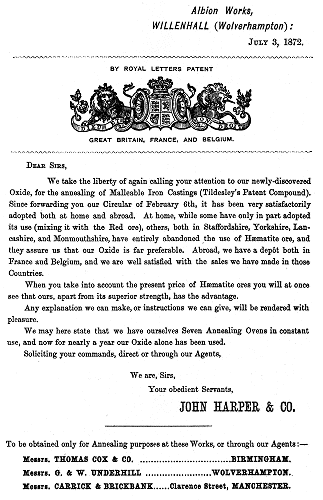 |
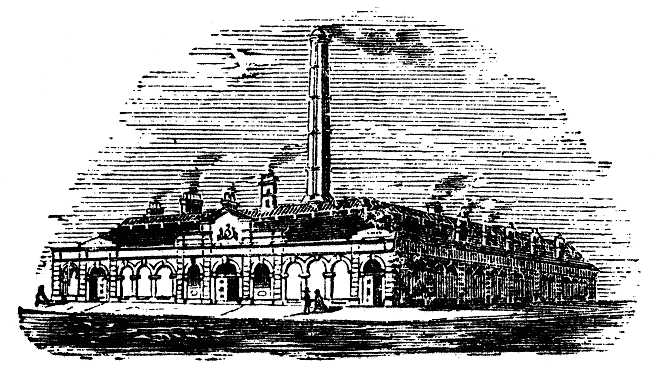
Albion Works.
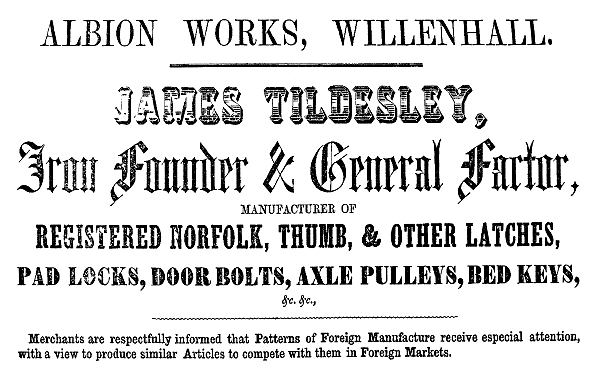
An advert from 1851.
|
Carpenter and Tildesley, Lock manufacturers, Summerford
Works, Willenhall
As Messrs. Chubbs' is the
representative factory in the lock trade in what is
known as the 'levered' department, so is that of Messrs.
Carpenter & Tildesley in what is known as the 'warded'
department, of this important industry. The Summerford
Works, situate at Willenhall, midway between
Wolverhampton and Walsall, were established by the late
Mr. James Carpenter, whose business as a lock
manufacturer in the town dates from the year 1795.
Mr. Carpenter was the first to
introduce rim iron into the construction of locks, but
his name is better known as the inventor and patentee of
the perpendicular motion in the working of lock bolts,
the use of which has now become almost universal. In the
year 1839 Mr. Carpenter took into partnership his
son-in-law, Mr. James Tildesley, the present sole
representative of the firm, who personally superintends
the entire operations of the establishment.
The Summerford Works give
employment to 150 pairs of hands, besides' out-workers,
and the average production of locks of the rim, dead,
drawback, and mortice descriptions, varying in size from
5 in. to 12 in., and in price from 10s. to 100s. per
dozen, is something like 250 dozens per week. Of these
the greater proportion are exported to the colonial and
other foreign markets, where the name of 'Carpenter' in
connection with the lock trade has long been familiar as
a household word.
|
|
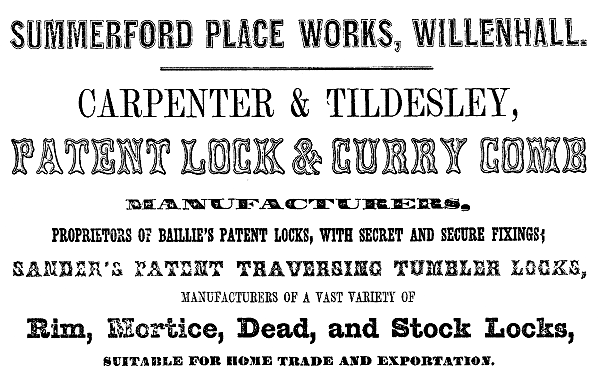
An advert from 1851. |
|
A noticeable feature of production
is the ‘double-handed' lock, the invention of Mr.
Tildesley's son, and which Mr. Tildesley has secured by
patent. The principle of this lock is, that it is
equally adapted to doors opening to the right or to the
left hand, and both the friction of working is reduced,
and the shape of the latch bolt is free from the
objectionable sharp angles of that in the ordinary lock.
The 'double-handed' lock is made both in rim and mortice,
and it already commands a very large sale, both in the
home and export markets.
Curry-combs to the number of 10,000
per week are also made at the Summerford Works,
principally for the United States, continental, and home
markets, and a large wood turnery is included in the
establishment, door-knobs and curry-comb handles being
the leading features of production. Rewards of merit for
locks, lock furniture, and currycombs have been awarded
to Messrs. Carpenter & Tildesley at the various
international exhibitions where examples of their
produce have been displayed. |

 |
Return to
the
previous page |
|